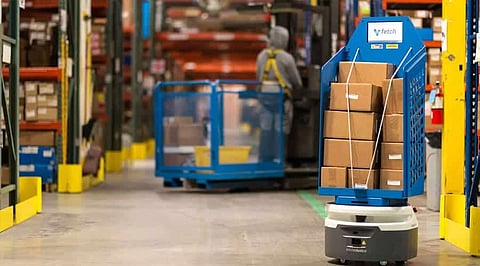

Robotics has resulted in a shift to the working system in recent years. Robots started filling the gap where labor was high and the work carried complications. One such place is the distribution network where Autonomous Mobile Robots (AMRs) are making their stand.
The past few decades have brought monumental changes to the world of order fulfilment and material handling. The spike in labor cost and shrinking of qualified workers has pushed the industry to look for alternative solutions. With available technological improvement across robotics, researchers added a new variety of robot to the warehouse robotics. Though certain types of warehouse robots such as AGVs, AS/RS, and others have already been around for years, many warehouse managers are finding themselves wondering about a new entrant called Autonomous Mobile Robots (AMRs).
Autonomous Mobile Robots (AMRs) are a simple, efficient and cost-effective way to automate material handling and in-house transportation tasks in nearly any situation where employees would previously have been required to push carts around the facility. AMRs understand and move through the environment without being overseen directly by an operator or on a fixed predetermined path. These robots have an array of sophisticated sensors that enable them to accept and interpret their environment, which helps them to perform their tasks in the most efficient manner and effectively navigate around fixed obstructions and variable obstructions.
While Automated Guided Vehicles (AGVs) carry out operations at rigid, preset routes, AMRs find the most efficient route to achieve each task and are designated to work collaboratively with operators such as picking and sortation operations.
AMR is a relatively young technology that is in the first stage of growth and adoption. However, it has already been branched according to its functions. Typically, AMRs can be split into three varieties,
Even though when transporting product from one end of the facility to the other end seems to be a low-skill task, it involves a lot of labor and cost. It is often the first task to be automated when an operation decides it is warranted. By automating product transportation within a facility, workers can stay in their primary work area in order to perform other more valuable tasks.
Earlier, only forklifts, conveyors and AGVs were committed to doing the groundwork at a warehouse. But today, a number of AMRs are being unravelled to fill the efficiency gap in functionality. Instead of working with only large and heavy loads, they are designated to pick-up and drop off individual cases and totes.
Order picking inside a warehouse is a time-consuming job. Physically walking from one location to another within the facility accounts for 75% of the time associated with picking. If AMRs overtake the job, it will leverage a variety of operations that can be brought to effect.
AMRs used in order picking: Associating AMRs with the warehouse jobs reduces the pickers travel time by bringing product to the picker. In zone picking, an AMR takes an order tote/bin to a shelving or rack location within a zone. A picker, working in the zone, is then able to select inventory from the surrounding locations to complete the order. Once the order is complete, the AMR will retrieve the tote and bring it to the next zone for further picking or to a packing station for final shipping. This process is repeated with multiple AMRs operating and transporting in many zones.
AMRs used in goods-to-person picking: Goods-to-Person picking involves storing multiple SKUs in sections of shelving, rack or bins. The AMRs are directed to retrieve a specific SKU found in the shelving. The bot manoeuvres under the shelving and lifts it off the ground. The AMR then moves via the shortest path to the designated pick station.
AMRs in the warehouse also play an important role in sortation. From conveyor roller to tilt trays and cross belt systems, AMRs are equipped for a wide range of sortation solutions.
Join our WhatsApp Channel to get the latest news, exclusives and videos on WhatsApp
_____________
Disclaimer: Analytics Insight does not provide financial advice or guidance. Also note that the cryptocurrencies mentioned/listed on the website could potentially be scams, i.e. designed to induce you to invest financial resources that may be lost forever and not be recoverable once investments are made. You are responsible for conducting your own research (DYOR) before making any investments. Read more here.
